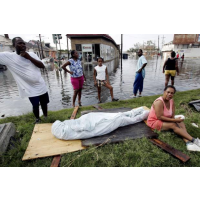Katrina and the Flooding of New Orleans: A Preventable Tragedy Caused by Cost Cutting, a Mistaken Test and Lack of External Review
 A woman sits beside the body of her husband in the aftermath of Hurricane Katrina (photo: Eric Gay, AP)
A woman sits beside the body of her husband in the aftermath of Hurricane Katrina (photo: Eric Gay, AP)
Just in time for the 10th anniversary of Hurricane Katrina, a new study (pdf) has been released that lays the blame for the failure of New Orleans’ levees at the feet of the U.S. Army Corps of Engineers.
Researchers found that because of a mistake the Corps made during testing, they recommended that the levee walls be started at a depth of 17 feet. Original estimates would have started the walls at a depth of 31 to 46 feet. However the use of a tarp along some of the test walls that distorted the test results, along with cost considerations, caused the Corps to go with the 17-foot depth. As a result, the walls failed.
The mistake made by the Corps was a misinterpretation of so-called E-99 tests conducted by the Corps several years earlier in the Atachafalaya Basin.
“As more information has emerged from the time of the disaster and its prior decision-making processes, new details allow us to have a better idea of the situation and what led to the various levee failures,” Missouri University of Science and Technology Professor J. David Rogers, the paper’s lead researcher, said. “This article is meant to put the record straight about the conclusions people drew from the disaster, many of which were based on incorrect information.”
Even after the faulty testing, the error might have been discovered if the Corps had subjected their test results to external review.
“The field tests were precisely what was needed to validate the design assumptions, but these were not subjected to peer review by anyone outside of the Corps because the services of (the Corps’ Waterways Experiment Station’s) permanent geotechnical consulting board had been terminated in 1978 as another federal cost-saving measure,” according to the report.
More than 1,800 people died and billions of dollars’ worth of property was destroyed in the floods that followed Katrina.
-Steve Straehley
To Learn More:
Flood Damage After Katrina Could Have Been Prevented, S&T Expert Says (by Mary Helen Stoltz, Missouri S&T)
Interaction Between the U.S. Army Corps of Engineers and the Orleans Levee Board Preceding the Drainage Canal Wall Failures and Catastrophic Flooding of New Orleans in 2005 (by J. David Rogers, G. Paul Kemp, H. J. Bosworth Jr. and Raymond B. Seed) (pdf)
Hurricane Expert Claims He was Fired by LSU for Speaking Out About Blame for Katrina Flooding (by Noel Brinkerhoff, AllGov)
- Top Stories
- Unusual News
- Where is the Money Going?
- Controversies
- U.S. and the World
- Appointments and Resignations
- Latest News
- Trump to Stop Deportations If…
- Trump Denounces World Series
- What If China Invaded the United States?
- Donald Trump Has a Mental Health Problem and It Has a Name
- Trump Goes on Renaming Frenzy






Comments